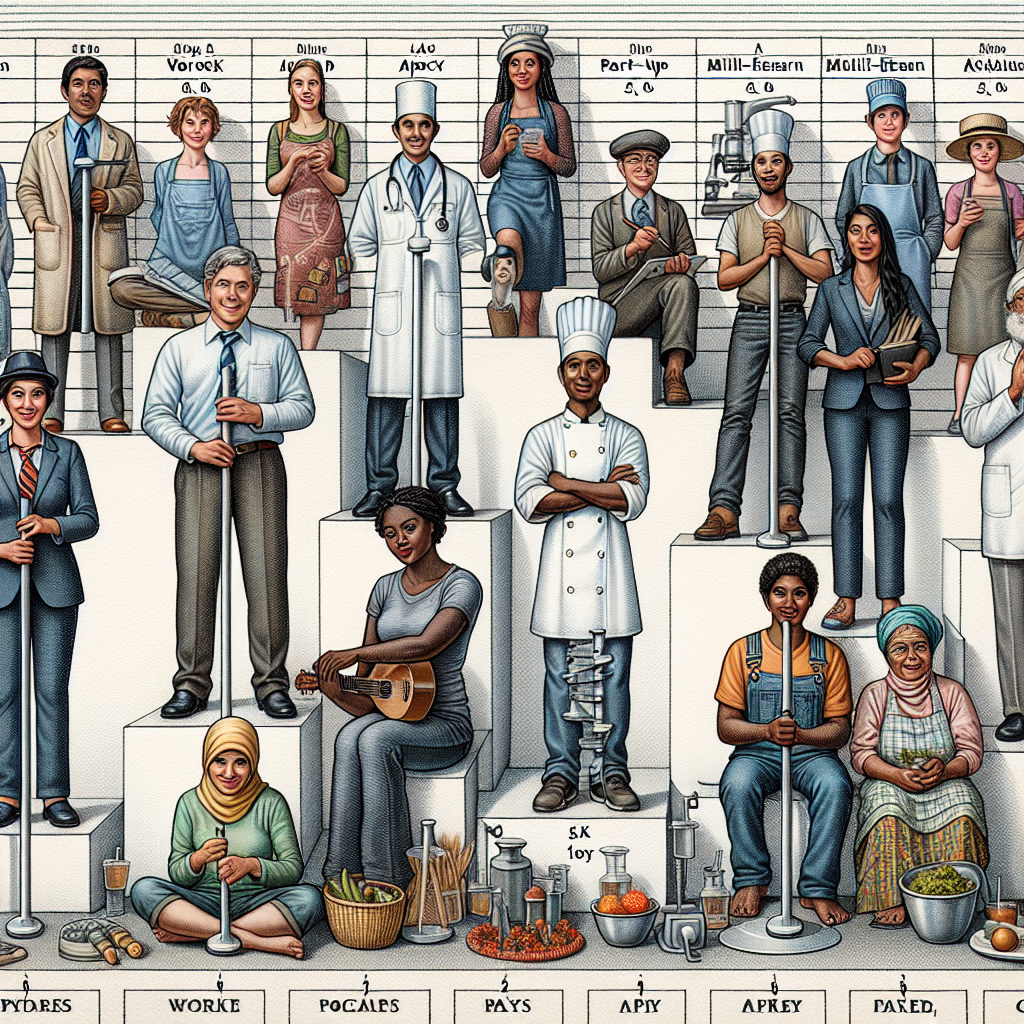Women across the U.S. are seizing the reins of their financial futures like never before, making savvy decisions with their money. Yet, despite this momentum, the persistent hurdle known as the gender pay gap remains firmly in place.
According to 2023 Census Bureau figures, women working full-time throughout the year earned just 83 cents for every dollar their male peers brought home. While the gender wage disparity has long been a glaring reality, Bankrate’s fresh dive into Census data reveals that the gap deepens considerably for women of color and those employed in sectors like finance and insurance — a stubborn stain that refuses to fade.
Not all women feel the pinch equally. The chasm widens markedly depending on one’s race, field, occupation, and even geography. Location alone can sway a woman’s paycheck in relation to a man’s, and despite record-high participation rates for women aged 25-54, education hasn’t closed the pay divide.
Ultimately, earning less hinders women’s capacity to build savings, reduce debt, and secure a stable financial footing. Over a typical 40-year career, women stand to forfeit more than $450,000 due to this pay imbalance. The stakes are even higher for Black and Hispanic women, whose lifetime losses hover around $1 million and $1.3 million respectively, Bankrate’s calculations indicate.
Shining a laser focus on these disparities, Bankrate combed through Census Bureau data to pinpoint where the most significant gender pay differentials take root — be it by industry, profession, or state — and who bears the brunt.
“At the heart of this issue lie systemic breakdowns — nothing women should blame themselves for. Swapping war stories, triumphs, and setbacks with fellow women spreads invaluable wisdom and wealth.”
— Cady North, Founder and CEO, North Financial Advisors
Essential Insights on the Gender Pay Gap
- The widest wage chasms exist for Black and Hispanic women. In 2023, Black women earned 67 cents, and Hispanic women just 58 cents, for every dollar earned by white, non-Hispanic men. White women made about 80 cents, while Asian women came closest to parity at 94 cents.
- Male-dominated industries — such as finance, insurance, science, and technology — show the broadest pay divides.
- Legal and sales roles feature the highest earnings discrepancies between genders.
- States like Utah and Louisiana exhibit the widest gender pay gaps, while Rhode Island boasts some of the narrowest.
Women of Color and the Steepest Pay Penalties
Black and Hispanic women shoulder the harshest financial disparities. Full-time, year-round Black women made only 67% of what white, non-Hispanic men earned in 2023, with Hispanic women trailing at 58%, as revealed through Bankrate’s scrutiny of Census Bureau data.
Meanwhile, Asian women edged near wage equality, securing 94 cents on the dollar compared to white, non-Hispanic men, while white women earned about 80 cents, mirroring the general gender gap.
Over the past 35 years, the wage gap has shrunk for all groups, but progress has been uneven:
- Asian women: +26 percentage points
- White women: +16 percentage points
- Black women: +8 percentage points
- Hispanic women: +5 percentage points
Experts point to discrimination, occupational sorting into lower-paid roles, and insufficient family-friendly policies as fueling the gap — hurdles especially towering for women of color, who face compounded challenges climbing the career ladder.
A 2023 Pew Research survey found nearly a quarter of working women experienced gender discrimination, compared to only 10% of men. Notably, even among Black and Hispanic women holding bachelor’s degrees or higher, wage disparities endure.
“The glass ceiling persists, blocking women from advancing in certain fields or roles. Despite claims of a ‘post-racial’ America, racial and ethnic biases stubbornly linger.”
— Dr. Nicole Smith
Where Industry Divides Expose the Starkest Wage Gaps
Though the wage gap touches every sector, Bankrate’s review of over 25 industries highlights finance and insurance as arenas where the gap yawns widest. Women represented 54% of the workforce in this sector in 2023 but only earned 63 cents on average to the dollar men earned, Census data confirms.
“Back in the ’80s, finance was a woman-free zone — female presence was almost alien. This industry is still relatively new in terms of welcoming women.”
— Cady North
Despite gains in female representation, North explains that women still face an uphill battle in finance, where bias and microaggressions chip away at retention and job satisfaction.
“Women often feel pressured to ‘play the man’s game,’ a frustrating dynamic that drives many away,” North adds.
Other sectors with significant pay disparities include:
- Finance, insurance, real estate, rental & leasing: 65.9%
- Management of companies and enterprises: 71.3%
- Health care and social assistance: 73%
- Professional, scientific, and technical services: 73.8%
Occupational segregation also exacerbates pay differences within industries. Women often cluster in lower-paying roles despite comparable education. STEM fields illustrate this trend vividly.
“Women tend to self-segregate in STEM, gravitating to areas like pharmaceuticals and biological sciences, which pay less and are female-dominated,” Smith notes.
Similarly, in education, men disproportionately ascend to higher-paying management posts, whereas women more frequently occupy lower-paying administrative roles, though more women major in education overall.
Conversely, some industries exhibit slimmer pay gaps, with construction leading at about 95 cents on the dollar. Other sectors with relatively narrow gaps include:
- Arts, entertainment, and recreation: 89.2%
- Real estate, rental & leasing: 88.7%
- Administrative and support and waste management services: 88.3%
Occupations with the Most Pronounced Gender Wage Divides
Delving into over 30 occupations, Bankrate pinpoints legal professions as having the steepest disparities, with women earning roughly 55 cents on the dollar compared to men in 2023.
Sales-related roles rank second, where women earn 56 cents per man’s dollar. Additional occupations with notable gaps include:
- Natural resources, construction, and maintenance: 64.2%
- Transportation: 64.6%
- Firefighter, prevention, protective services (including supervisors): 66.8%
Jobs with minimal or nonexistent pay gaps tend to be female-dominated, such as:
- Community and social service: 97.7%
- Health care support: 94%
- Office and administrative support: 89.9%
- Life, physical, and social science: 89.5%
- Architecture and engineering: 85.5%
Geographic Pay Disparities: Where the Gap Widens and Narrows
Your zip code can dictate your paycheck, lifestyle, and overall well-being — a fact especially true for women. State-level pay disparities reflect differences in dominant industries, occupations, and workforce demographics.
States with the Narrowest Gender Pay Gaps
| Rhode Island | $70,274 | $62,763 | 89.3% |
| Vermont | $63,691 | $55,832 | 87.7% |
| New York | $71,168 | $62,111 | 87.3% |
| California | $70,692 | $61,544 | 87.1% |
| Hawaii | $62,489 | $54,348 | 87.0% |
States Bearing the Widest Gender Pay Gaps
| Louisiana | $60,294 | $42,954 | 71.2% |
| Utah | $70,008 | $50,852 | 72.6% |
| Alabama | $58,319 | $43,074 | 73.9% |
| Wyoming | $62,142 | $45,971 | 74.0% |
| North Dakota | $67,128 | $50,587 | 75.4% |
The Road Ahead: What Lies Beyond the Gender Pay Gap?
The lens through which we view wage equality shifts with perspective. In 1988, women earned about 66% of men’s wages; by 2023, that share had climbed to 83%, per Census data.
However, the past 20 years have witnessed a plateau of sorts. Between 2000 and 2010, the gap narrowed by only three percentage points, with a slightly larger six-point improvement following through 2023.
According to Dr. Nicole Smith, the stagnation stems from multiple intertwined factors — insufficient advancements in workplace policies like paid family leave and childcare support; women’s educational and occupational choices; continued discrimination; and broad economic shifts. Women’s disproportionate caregiving burdens often compel compromises such as opting for lower wages or exiting the workforce to juggle family duties.
“Many women face tough crossroads, influencing both their career paths and paychecks. The workplace environment often lacks the support that would keep women engaged long term.”
— Dr. Nicole Smith, Chief Economist, Georgetown University Center on Education and the Workforce
Three Practical Ways Women Can Strengthen Their Financial Standing
Fixing the gender pay gap isn’t solely a woman’s burden, but taking proactive steps can boost confidence and self-advocacy even when resources are limited. Here’s how:
- Build an emergency stash: Even small weekly contributions to a savings pot matter. For investors, index funds offer broad diversification while minimizing costs and risks over time.
- Master the art of salary negotiation and transparency: Arrive armed with concrete evidence of your recent achievements and use online tools to gauge fair pay for your role, experience, and locale. Going a step further, discuss salary ranges openly within your network to normalize pay transparency.
“We have to enter those boardrooms and meetings knowing our worth and negotiate assertively from the jump. Without relentless advocacy, this conversation will echo a decade from now.” — Dr. Nicole Smith
How This Analysis Was Conducted
Bankrate’s examination drew on data from the U.S. Census Bureau’s Current Population Survey Annual Social and Economic Supplement (ASEC) and the American Community Survey (ACS). To gauge pay gaps among racial and ethnic groups from 1988 to 2023, median annual earnings of full-time, year-round workers 15 years and older were analyzed. State, industry, and occupational pay disparities for 2023 reference median earnings of full-time workers aged 16 and above. All income figures were inflation-adjusted to maintain consistency.



